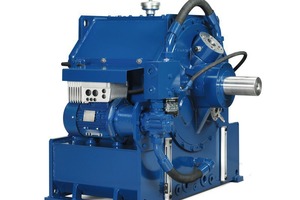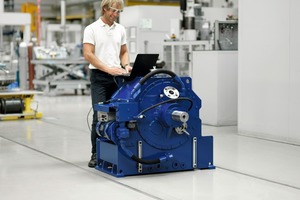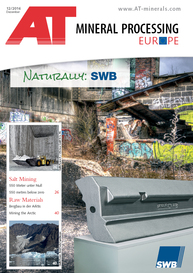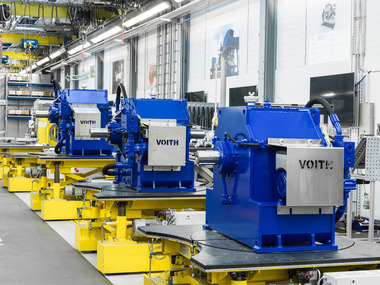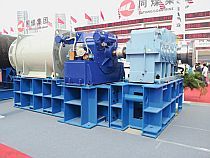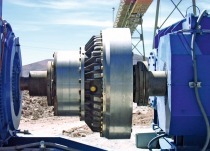Intelligent Driving of Belt Conveyor Systems
Voith recently unveiled its new TurboBelt 500 TPXL fluid coupling at MINExpo in Las Vegas/USA (Fig. 1). The fill-controlled coupling is the first model in the new TPXL family, which combines the advantages of the proven hydrodynamic drive principle with intelligent control technology. The integrated controller makes it possible to adapt the output torque of the coupling exactly to the startup parameters of the belt conveyor system. In addition, Voith‘s engineers have been able to considerably reduce the dimensions of the new coupling, so that the TurboBelt 500 TPXL only requires half the volume of conventional coupling types for the same force transmission. In addition to the operational advantages, the new series of couplings also offers attractive procurement and operating costs.
Operation of the TurboBelt 500 TPXL is simple and user-friendly: After the required torque for the belt and the basic startup parameters have been transmitted, the coupling automatically calculates the optimum fill level in real time and fills or drains the working circuit accordingly. Equipped with a self learning function, it simultaneously stores all relevant operational data in order to align the control behavior optionally with the nominal value, depending on the respective load situation and on the basis of previous empirical values.
This is enabled by the plug-and-play design of the TurboBelt 500 TPXL. An integrated controller, an integrated pump and a new oil supply unit are part of the coupling concept. Thus the components are optimally matched to one another and pave the way for predictive, requirement-oriented and cost optimized maintenance of the coupling. The controller monitors the entire sensor system of the coupling and provides operationally relevant information, such as the condition of the oil filter. Even by remote access, if desired.
As a self-contained system, the coupling can be easily put into operation without long interruptions in production. In order to allow for the integration into new as well as existing drive trains, Voith offers a version with bearings on both sides for standalone use as well as a variant with bearings on the output side for direct motor connection.
Wear-Free and Compact Thanks to Hydrodynamics
Thanks to the hydrodynamic operating principle, power transmission via the TurboBelt 500 TPXL is wear-free and does not require a mechanical connection. New vanes with the XL profile double the power density of the coupling in comparison to conventional coupling types. This means that only half the volume is required to transmit the same force.
The hydrodynamic circuit of the coupling limits the torque in the driveline to a fixed, defined value which protects the belt and the drive components from damage due to overloading. This minimizes maintenance costs and increases the lifetime of the system. Motors can be run up to speed under no-load conditions and staggered in time using the fill control system. This minimizes the current peaks that always occur when motors are switched on and reduces the load placed on the power grid.
Intelligent and Reliable
In parallel with the integrated controller unit, which controls the oil supply to the working circuit among other things, the TurboBelt 500 TPXL is also equipped with a fieldbus unit (Fig. 2). With this, Voith lays the foundation for the mining of the future. Thanks to connected components over the entire extraction process, operators can profit from high conveyance performance and increased productivity as well as from increased work safety.
Within the Voith portfolio the TurboBelt TPXL fill-controlled coupling is complemented by components over the entire conveying process such as the intermediate drive TurboBelt TT Linear Booster Drive, storage loops, tension stations and slide and chute systems. Today, this already offers diverse possibilities for optimizing belt conveyor systems with respect to total cost of ownership and capital expenditures. Furthermore the wide product range opens a perspective for the future with regard to automation concepts and comprehensive condition monitoring.
$(LEhttp://

